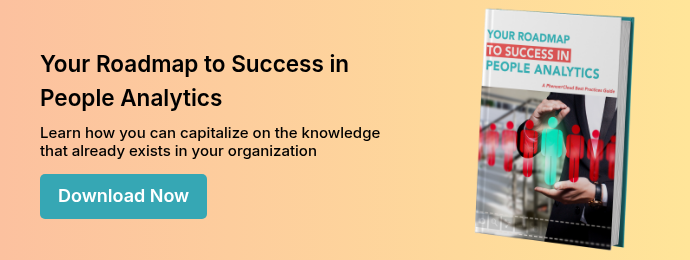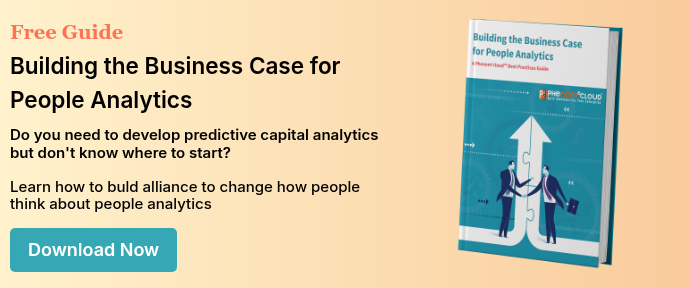
In recent years, interest in people analytics has been more hype and hope than results. Most organizations are still doing what they have always done, but the promised revolution in HR shows signs of life.
Eighty-five percent of organizations in an August 2016 New Talent Management Network survey said they were performing some people analytics, and 69% of those who are not stated that they would start within the next 12 months.[1]
Bersin by Deloitte reported a 29% increase from 2015 to 2016 in the number of organizations using people data to predict business performance,[2] and Josh Bersin seems optimistic, a contrast to his gloomy outlook in 2015.
"In 2017 we will see analytics move from a niche group in HR to an important operational business function."
Josh Bersin: “Predictions for the Year Ahead,” January 19, 2017.
Start Small and Grow Your Team
Embarking on the analytics journey may seem like an impossible task, but we want to encourage you to get started. All the organizations we work with have started with a small initiative and grown their capabilities over time, and sometimes a small initiative can create astonishing results.
You don’t need a huge budget and a world-class analytics team to make an impact on business results, but you need the right team. People analytics is more than the data in your HR database and talent management technology; much of the information you need for productive people analytics lives outside HR applications. You will need to form alliances inside and outside your organization.
One of the primary criticisms of HR over the past few years has been the lack of analytical skill in HR. Finance and Marketing have become analytical pros while HR lagged. Few of us current or former HR practitioners came into the profession with an analytical mindset. Even those of us who studied analytics in psychology, sociology, or economics left statistical analysis behind so we could do “people work.”
You not become a data scientist, but you do need one. You will also need other skills you don’t have in your organization. If you can’t borrow them from Finance or Marketing, a consulting partner can give you a way to control your costs and still get all the help you need. Data scientists and technical skills are expensive. It is often better to rent than buy. Find a partner who understands your need.
What Skill Set Do You Need for People Analytics?
A people analytics team requires expert knowledge in every area of human capital management, but many of the skills required rarely reside in HR.
- Visionary Leadership. When you are starting a new initiative, the ability to frame and communicate the future state is an essential skill. A visionary leader can create a picture of the future in every team member's mind and motivate them to want to achieve it. If that is you, great. If not, you will need a visionary ally.
- Business Acumen. More than in-depth knowledge of your company, your business model, and your
 industry, this skill includes an understanding of how your firm makes money capitalizes on opportunities as they arise.
industry, this skill includes an understanding of how your firm makes money capitalizes on opportunities as they arise. - HR Expertise. Knowledge and experience in every HR function are necessary, but we also recommend high expertise in organizational behavior, at the intersection of psychology, sociology, and anthropology. You will explore how human behavior affects the enterprise and vice versa. Your best ally may be your CFO or another member of the Finance team.
- Technology Infrastructure. As you grow your analytics capability, you will need access to data wherever it is: in your software, elsewhere in your company, or outside it. You also need to deliver insights wherever your people or partners need them.
- Data Management. If your organization does not have a master data management plan and a data governance body, this is the time to start the conversation. You should manage everything you do with data according to the standards in your organization. If you need to break down organizational silos, unified data management is an excellent way to do it. A robust data master plan will strike the right balance between control and autonomy.
- Data science, analytics, and visualization. You may be fortunate enough to have a data scientist or partner who can manage all three roles, but frequently you will have several people in these functions. Your best plan may be to engage the skills on an ad hoc basis while you grow analytics and visualization capability in your HR group.
- Marketing. How well your business leaders receive your analyses and recommendations will depend on how well you market your efforts. Partner with Marketing to make sure you deliver with impact.
Success begets success. As you impact the business, you will create a demand for more insights. It will take time to get there, by having the fight team in place will give you a good start.
References:
1. "Still Under Construction: The State of HR Analytics 2016." New Talent Management Group. August 2016. Retrieved November 14, 2016.
2. Bersin, Josh. Predictions for 2017: Everything is Becoming Digital. Bersin by Deloitte. Retrieved January 17, 2017.
PhenomᵉCloud is a comprehensive technology solutions provider committed to empowering businesses to overcome challenges, enhance their workforce capabilities, and achieve superior outcomes.



Leave a Comment